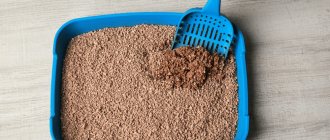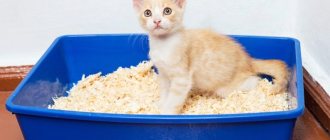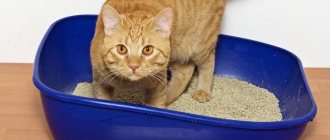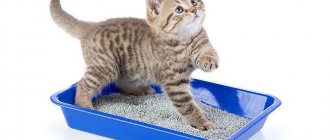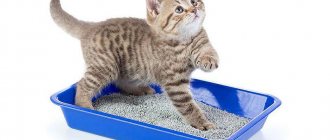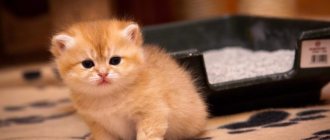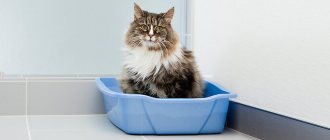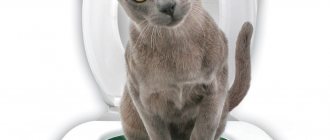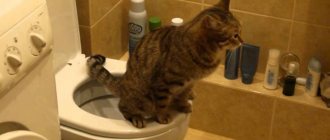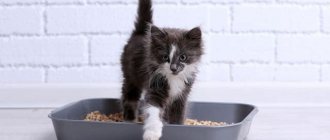Usually pets are toilet trained using their mother's example. Learning occurs in the third week of life. As a result, by the time it moves to a new owner, the animal already has the necessary skills. However, it happens that a person picks up his pet on the street. In this case, the suggested methods will help teach him to go to the toilet.
Will a toilet training spray help cats?
Spray for habituation of kittens acts individually on representatives of the cat family. Each creature has its own sense of smell and attractive smell. The spray will not help some, but will suit others.
Manufacturers are trying to make universal products with enzymes that attract cats. With them, the animal will begin to go where it needs to, but it is impossible to take into account individual characteristics.
Almost all sprays contain an analogue of a natural beacon that makes you want to go to the toilet. If the spray suits the cat, results can be expected within 1-5 days. The effect will not disappear after stopping use.
Under the influence of the spray, the cat develops a strong habit of going to the required place. If the purchased product is not suitable, it is possible that drops of a different brand will do.
The spray acts quickly on the animal, acting on the neural connections of the brain and causing the corresponding reflexes. It has a specific smell, but not too pungent, so it will not cause discomfort to the owner. If a kitten owner wants to save time, they should try a litter box training spray.
Use of special means
To simplify the task for owners, a special tool for training a kitten to the tray called “Smart Spray” will help. Its smell attracts animals and signals that the area can be defecated. The product is sprayed onto a piece of paper, which is placed in the tray, or the filler is sprayed directly. After this, you need to bring your pet to the tray so that he gets acquainted with his toilet.
There are also products to protect areas that are not intended for the toilet. Mostly they are also available in the form of a spray, but have a repulsive odor. This product should be sprayed on the places where the kitten shits. It can be applied not only to the floor, but also to surrounding objects, for example, a sofa, wall, cabinet, curtains and so on.
All specialized products are completely safe for pets and do not harm their health in any way.
To learn how to properly train a kitten to use a litter tray, watch the following video.
How to make a litter box attractive to a kitten
Cats are designed in such a way that they will never defecate in places where they are uncomfortable doing so or where the place is not well equipped. Therefore, there are several rules that will help your kitten avoid discomfort:
- Select the desired tray size. It should be larger and longer than the animal.
- Clean your cat's litter with natural products. A kitten or an adult will not be attracted to the so-called “smell of cleanliness,” that is, harmful chemicals. Therefore, you need to use the right drugs. After cleaning, it is enough to treat it with a smart spray and the kitten is again ready to go to the litter box following the familiar marks.
- If a cat poops past the litter box, you need to spray the spray on a piece of newspaper near the pet’s usual place to defecate, and gradually move the treated item to the cat’s litter box.
- Location. This is also important for litter box training. Don't place the toilet next to a bowl; instead, choose a secluded and comfortable location for bowel movements.
- Choose a litter for your kitten that he likes: clumping, absorbent, wood and silica gel.
Cats have their own hygiene rules. The pot should always be clean and have an identifiable aroma. Initially, the litter box may smell like cat spray. The toilet, in turn, should be located far from the bowl and drinking bowl.
Additionally, you should wash the floor using a weak vinegar solution so that the cat does not repeat the “exploits” in the wrong place. By following these simple rules, you can easily teach yourself to defecate in the right place.
Choosing a filler
There are several types of industrial fillers. And there are always free options - newspaper, sand, earth. Some people don't use filler at all.
Wood filler
This is the most suitable option for a kitten. It is environmentally friendly and safe. If the baby chews the filler, which often happens, nothing bad will happen. This is also a very good and inexpensive option for adult cats. The filler is produced in the form of compressed granules, which crumble when wet, evenly distributed along the bottom of the tray. Wood absorbs moisture well, but quickly exhausts its absorption reserve. Therefore, you will have to change such a filler quite often, at least twice a week, otherwise dampness and an unpleasant odor cannot be avoided. It can be flushed down the toilet, but not all at once, but in parts. Experts do not recommend using litter with aromatic additives. They may be harmful to the pet or simply not to their liking and thus scare them away.
Wood litter for cat litter is safe and environmentally friendly
Clay filler
Clumping litter is made from minerals and bentonite clay. Moisture causes it to form into lumps, which can be removed with a scoop without replacing the filler. A very convenient option for busy people.
You can purchase absorbent clay litter. It retains moisture without forming lumps. This filler needs to be completely changed regularly. But you should remember that this type is not suitable for kittens, because they can eat it and get an intestinal blockage . It’s not very convenient that it sticks to the paws and spreads around the apartment. And also, some cats may experience irritation of the mucous membranes from the dust generated during raking. Clay litter should not be flushed down the toilet.
Mineral filler is easy to use and economical
Silica gel
Silica gel filler absorbs a large amount of moisture and retains odor well. You can judge whether it needs to be replaced by a change in color. The disadvantage of this option can be considered its higher cost compared to the previous ones.
Silica gel filler absorbs unpleasant odors and retains moisture
What other fillers are there?
You can rarely find corn litter in pet stores. According to the principle of action, it is similar to wood. It is environmentally friendly, affordable, and emits a popcorn aroma when wet. Cats love to rummage through this litter. However, it is quite loose and light, so you will need a tray with high sides.
It is extremely rare to find various fillers from Japan in pet stores. Basically, they can only be purchased online. Their price is high, but it is justified by their hypoallergenicity, convenience and exoticism. It can be:
- granules made of paper and starch with a color indicator of contamination;
- small cypress wood cylinders;
- backfill made of cellulose with activated carbon;
- filling made from pressed soy fibers.
Sawdust can be used as a “folk” filler. This is probably the most successful option, but they retain moisture and odor worse than industrial wood filler, so they need to be changed every two days.
You can do without litter at all if you have enough free time to keep your pet’s toilet clean. Install a tray with a grid for him: all the moisture will flow down, and his paws will remain dry and clean. But keep in mind that such a toilet will need to be rinsed after each use and thoroughly washed once a day.
Table: cat litter
| Name | Compound | Price | pros | Minuses | Replacement frequency |
| Silica gel | Silicon dioxide granules | 300–350 rubles for 3 liters |
|
| Twice a month |
| Mineral clumping | Minerals and bentonite clay | Within 100 rubles for 3 liters |
|
| Does not require complete replacement |
| Mineral absorbent | Clay | 200–250 rubles for 15 liters |
|
| Once or twice a week |
| Wood pellets | Compressed sawdust | Within 100 rubles for 3 liters, 150 rubles for 12 liters |
|
| Two times a week |
| Corn filler | Corn granules | 160 rubles for 3 liters, 250 rubles for 6 liters |
|
| Once a week |
| Sawdust | Wood | 250 rubles for 14 liters |
|
| Of necessity |
| Japanese fillers |
| From 1 thousand rubles for 5–7 liters |
|
| According to instructions |
| Empty tray with grid | — | — |
| It is necessary to constantly monitor the cleanliness of the tray. | After each use |
Means to prevent cats from shitting in corners and tearing up furniture with wallpaper
A kitten, like a child, needs to be raised, and the pet does not understand what is bad and what is good. Therefore, if small dirty tricks are detected, you should try to wean your pet from tearing up furniture. Means of combating this phenomenon can be:
- Repellent spray (the complete opposite of the previous drug).
- A scratching post will help wean the animal from damaging furniture.
- Trim your cat's nails, or buy anti-scratch claws.
- Some people use the kitten declawing method, but this method is best avoided.
People have long been faced with the problem of furniture damage; there are folk remedies:
- Every time the cat is going to spoil the furniture or shit, you can give the pet a cold shower with a spray bottle. This manipulation will affect the pet’s psyche and it will associate illegal actions with unpleasant sensations.
- Place citrus fruits next to your favorite sofa or wallpaper: this smell is unpleasant for cats.
The reason why a cat scratches the floor and tears up wallpaper is commonplace - sharpening its claws. The animal cannot stop doing this, so it is better to choose an alternative for the animal, in the form of a scratching post. The spray can only cause hostility, but it is not able to discourage natural cravings.
Having an animal is a big responsibility, and before you take someone into your home, you need to prepare a comfortable environment for it. Then the animal will bring only joy to the house and you won’t know what tattered wallpaper and shabby furniture are, and you won’t find stinking hiding places with cat feces.
Quarantine
Of course, the reaction of an old-timer to a young guest in the form of hissing, growling, snorting and fur standing on end is quite natural.
Therefore, usually, when bringing a kitten into the house, he is not introduced to the cat right away. And they do it gradually. At first, the pets are placed separately. Some animal psychologists recommend placing the cat and kitten in different but adjacent rooms, and covering the doorway with mesh. This way the pets will feel each other, but will not touch each other. If desired, they can always communicate. Bowls should be placed on both sides of the net, in which there should always be water and food - the cats will be kinder and more accommodating. In order for animals to quickly get used to new smells, it is recommended to change places, but still keep them isolated. After about a week, when the pets get used to it and are no longer afraid, they can be released. But they should still be under the supervision of the owner. Any undesirable behavior towards a neighbor - a blow with a paw, hissing - should be stopped. However, repeated isolation is only required if the animals begin to fight (not to be confused with play). In case of an aggressive reaction, the animals are again divided for the same period. Then the introduction is repeated.
Review of popular sprays
What are the best toilet training sprays for cats? The most popular products today are the following brands:
- "My place!" (). Spray lotion supplied in 180 ml bottles. Contains active ingredients (carbon dioxide, carbamide, PVPyridone), water, preservatives. Price per package – 139 rubles. The method of application is standard. Suitable for cats of any age.
- “Toilet training” (“Khimol”). Spray in 150 ml bottles equipped with a convenient spray dispenser. Price per piece – 123 rubles. Shelf life – 12 months. The product is applied by spraying directly into the tray from a distance of 20–30 cm. It is most effective when used in combination with drugs that wean pets to relieve themselves in inappropriate places. The spray is non-toxic and biodegradable.
- “Smart spray” (“Api-San”). The transparent, non-marking liquid is sold in 200 and 250 ml bottles equipped with a sprayer. The method of using the product is standard. The recommended frequency of use is three times a day until the desired effect is achieved. The spray contains an anionic surfactant, distilled water and fragrances to imitate the natural smell of cat urine. The permissible shelf life of an opened bottle is 2 years.
It is worth noting that the effectiveness of a particular drug is a very relative concept. Each individual animal differs from its relatives in its own unique perception of surrounding odors. Accordingly, a remedy that works on one cat may be completely ineffective on another, even if the animals grew up in the same conditions and live in the same territory.
